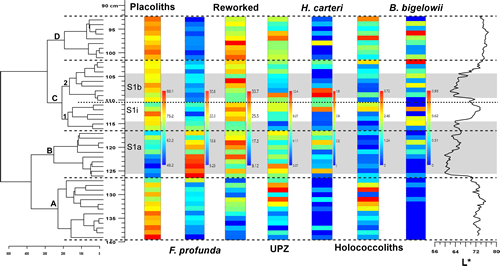The response of calcareous plankton to the Sapropel S1 interval in North Ionian Sea

Cascella A., S. Bonomo, F. Lirer, G. Margaritelli, H. Checa, I. Cacho, L. D. Pena, J. Frigola (2021).
Global and Planetary Change, 205, https://doi.org/10.1016/j.gloplacha.2021.103599.
Abstract
A high resolution study of calcareous nannofossils has been performed on samples from the Sapropel S1interval deposited in the North Ionian Sea, with the aim to assess the paleoenvironmental changes in the photic zone during this crucial interval in Mediterranean circulation. Calcareous nannofossil data have been integrated with planktonic foraminiferal data recently published from which the paleoclimatic curve has been constructed.
Placoliths (namely Emiliania huxleyi) and Florisphaera profunda distributions, along with that of planktonic foraminifer Globigerinoides ruber white, evidence that, after a progressive weakening of surface water mixing, a deep chlorophyll maximum developed just prior to the sapropel deposition. We suggest that these changes took place as a response to enhanced precipitation conditions and riverine discharge as testified by increasing trend of reworked coccoliths and the occurrence of lower salinity taxon Braarudosphaera bigelowii. Calcareous nannofossils also point out that the oceanographic (water column stratification, reduced bottom water ventilation) and biogeochemical (increased primary production) processes that occurred during the S1 formation were particularly dominant during the earliest part of the older S1 warm phase (S1a). Our results support than some re-ventilation events of the shallow depth of studied site (665 m) occurred to some extent, particularly during the final phases of S1a.
The distribution of holococcoliths, more abundant during the cold interruption phase S1i, seems confirm that the preservation of these tiny and delicate coccoliths, highly susceptible to dissolution, is enhanced under seafloor re-ventilation conditions.
Finally, we tentatively suggest that preservation also plays a significant role in the distribution of the warm upper photic zone taxa, particularly during the warm S1b interval.


Devi effettuare l'accesso per postare un commento.